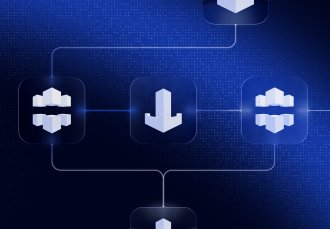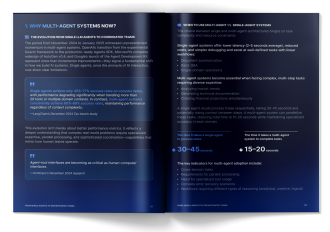
Contact us
Our team would love to hear from you.

Selecting a protocol is more than just a technical choice—it’s a strategic decision. The system’s architecture determines its scalability limits and ultimately determines what your AI infrastructure can and cannot achieve for the business.
In this article, we’ll break down the core capabilities, practical use cases, key challenges, and strategies to integrate protocols in your system.
AI communication protocols provide the core capabilities required to build a cohesive, scalable, and secure multi-agent system.
This capability ensures that agents developed on different platforms can exchange information without misinterpretation. It is achieved by defining a common format and vocabulary for all communications.
Across these protocols, JSON is standard: the Model Context Protocol (MCP) and Agent2Agent (A2A) use JSON‑RPC 2.0 message envelopes, while ACP exposes a REST+JSON surface. But JSON‑RPC is only one of A2A’s bindings. Protocols specify the exact structure of a message, for instance, requiring that a “task request” contain a task_id, description, and structured payload. This standardization ensures an agent built with one framework can correctly process a request from an agent built with another, preventing data corruption.
Protocols provide mechanisms to manage complex workflows distributed across multiple autonomous agents, including task assignment, synchronization, and conflict resolution.
This is implemented through a standardized task life cycle defined in protocols like A2A, which uses interrupting states—such as input-required and auth-required—as well as terminal states such as canceled or rejected. This framework enables advanced delegation, allowing agents to negotiate taking on tasks based on their advertised capabilities, typically through messages before a task is created.
This capability ensures the agent network is robust, safe, and equipped for failures. It integrates security for data protection with resilience patterns for operational stability.

The following AI communication protocol use cases showcase the role this technology plays in specific systems.
In enterprises, AI communication protocols operate at the data and workflow integration level. They enable large language model (LLM) integrations with internal APIs, enterprise agent interoperability, dynamic prompt construction, and multi-agent collaboration frameworks.
A global bank deploying an employee assistant must retrieve data from Salesforce, HR onboarding platforms, and internal knowledge bases simultaneously. Traditionally, each connection would require custom engineering. With MCP, these systems can be exposed to the assistant through a standardized interface, allowing the assistant to compose dynamic prompts and deliver unified answers.
Another example comes from enterprise sales and support teams, where autonomous agents operate across different departments to manage leads and handle customer inquiries. Without a shared communication framework, they risk duplicating operations or missing critical context. A2A solves this by enabling agents to share capabilities, exchange deal data, and coordinate task life cycles in real time, creating seamless data sharing across the organization.
Building a system on different platforms is not an easy task. The standardized data formats used in AI communication protocols make it possible to create cross-platform agent ecosystems and support distributed agent orchestration.
A retail company may use Vertex AI for demand forecasting, HuggingFace for natural language analysis of customer feedback, and LangChain for chatbot orchestration—all with the aim of delivering a seamless customer experience. ACP, based on REST, enables fast integration and discovery across platforms, allowing businesses to collect customer insights and speed up decision-making.
In a multi-vendor marketplace, agents representing logistics providers, payment processors, and stores must coordinate checkout and delivery processes. Implementing A2A in these activities allows these agents to negotiate tasks across vendors, enabling courier reservations, payment processing, and inventory updates without relying on fragile custom integrations.

AI communication protocols allow developers to manage multi-agent orchestration on edge devices. They also support local-first LLM systems that handle sensor inputs, trigger real-time actions, and operate within autonomous runtime environments.
A smart home environment requires privacy-preserving orchestration. Imagine voice-controlled devices that adjust lighting, manage heating, and monitor security feeds. Homeowners may not want this sensitive data sent to the cloud. MCP enables local-first LLMs to access on-device tools and trigger safe actions directly, ensuring commands are executed quickly and privately.
AI communication protocols enable peer-to-peer (P2P) agent networks, distributed decision-making, and resilient collaboration across blockchain and trustless environments. By standardizing interactions, these protocols ensure agents can exchange information, validate actions, and perform autonomous operations without a central authority.
A group of universities created an open research network where AI agents exchange models and datasets P2P. Instead of relying on a central server, they use ANP, an agentic communication protocol that leverages DIDs and encryption to enable trusted, secure collaboration across institutions.
Similarly, in decentralized finance (DeFi), agents representing banks, auditors, and exchanges must validate transactions and maintain compliance. ANP allows these agents to identify each other’s actions transparently, maintaining both resilience and security in a trustless ecosystem.
When using AI communication protocols, it’s important to consider their inherent limitations. Recognizing these gaps enables teams to design more resilient and robust systems.
A2A and ACP rely on existing enterprise authentication, which can fail in multi-organization environments, potentially disrupting agent collaboration and workflow continuity.
To address this, teams should standardize on OAuth/OIDC with authenticated extended Agent Cards, OAuth2/Bearer, mTLS, and JWT/JWKS where applicable. For zero-trust or decentralized deployments, experimenting with ANP’s DID-based authentication offers a more resilient, vendor-neutral alternative.
Managing multi-hour tasks and retries across agents can be challenging, risking incomplete workflows or data loss. Using A2A’s task life cycle alongside SSE streaming enables more robust orchestration. MCP users should follow its resumability guidance for Streamable HTTP to ensure reliable task execution, with redelivery via Last-Event-ID.
Complex multi-agent chains are difficult to trace, complicating debugging and compliance reporting. Standardizing metadata—such as ACP citations, trajectory tracking, correlating task IDs in A2A, and centralizing provenance logs—can maintain transparency and make multi-agent operations auditable.
With ACP merged into A2A, its road map and governance have shifted, creating uncertainty for future integrations. To mitigate risk, adopt A2A for all new cross-vendor deployments while retaining ACP compatibility layers for existing REST-based infrastructure. MCP remains stable for direct app-to-tool access.
Think of challenges as design constraints rather than obstacles. With the right mitigation strategies, each protocol can still be deployed effectively, depending on your context.
You don’t have to pick just one communication protocol. Many real-world systems combine them; for example, using MCP for in-app tool integration and A2A to orchestrate agents across vendors. The right choice depends on the problem you need to solve, your current system architecture, and your long-term vision for the agent ecosystem.

It depends on your context: A2A could become the enterprise default as adoption grows, supported by Linux Foundation governance and strong vendor backing. MCP is stable and will remain the preferred choice for LLM-to-tool integration. ANP will gain prominence if decentralized identity and P2P agent networks take off. ACP will gradually merge into A2A but remains relevant for REST-centric teams in the near term.
MCP: Spec and documentation and the official MCP Registry announcement stream.
A2A: Project docs and spec under the Linux Foundation/A2A Project GitHub.
ACP: IBM Research page and ACP GitHub now point to A2A migration guidance.
ANP: Open-source software (OSS) repo and white paper.
Yes, EffectiveSoft can integrate protocols like MCP, ACP, A2A, and ANP into existing AI systems by adapting current architectures, enabling structured tool access, secure inter-agent communication, and network-wide agent discovery. Our team ensures smooth compatibility, strong security, and ongoing support so your AI ecosystem remains reliable as these standards evolve.
An Agent Communication Protocol (ACP) is a standardized set of rules and formats that enable software agents to exchange information and coordinate actions efficiently. ACP ensures that agents can interpret each other’s messages accurately, even if they were developed independently or operate in different systems.
Improved collaboration: Agents can coordinate complex tasks without human intervention.
Automation and efficiency: Processes are streamlined as agents exchange information seamlessly.
Consistency and reliability: Standardized protocols reduce miscommunication and errors.
Scalability: Businesses can deploy more agents without worrying about compatibility issues.
Faster decision-making: Real-time information exchange allows for quicker responses to changing conditions.
AI communication protocols are particularly valuable in industries that rely on complex, distributed systems or real-time decision-making, such as finance and banking (algorithmic trading, fraud detection, and risk management), supply chain and logistics (real-time tracking and automated coordination), healthcare (patient data integration and AI-assisted diagnostics), manufacturing and industry 4.0 (smart factories and predictive maintenance), telecommunications (network management and autonomous service orchestration).
Yes, by providing a standardized framework for agent interaction, multi-agent protocols reduce the need to build custom communication systems from scratch. This leads to lower development costs due to reusable components, faster integration across different systems, reduced testing complexity because agents follow a predictable communication standard and accelerated time-to-market for AI-driven solutions.
Absolutely, modern AI communication protocols are designed to be flexible and can interface with existing enterprise systems through APIs, middleware, or adapters. This allows businesses to enhance legacy infrastructure with AI capabilities without requiring a full system overhaul.
Can’t find the answer you are looking for?
Contact us and we will get in touch with you shortly.
Our team would love to hear from you.
Fill out the form, and we’ve got you covered.
What happens next?
San Diego, California
4445 Eastgate Mall, Suite 200
92121, 1-800-288-9659
San Francisco, California
50 California St #1500
94111, 1-800-288-9659
Pittsburgh, Pennsylvania
One Oxford Centre, 500 Grant St Suite 2900
15219, 1-800-288-9659
Durham, North Carolina
RTP Meridian, 2530 Meridian Pkwy Suite 300
27713, 1-800-288-9659
San Jose, Costa Rica
Escazú Corporate Centre, Piso 6
40602, 1-800-288-9659